In the early 1900s, a cat named Lillian Russell who liked to fish made a name for herself as the mascot cat of the Dyker Meadow Golf Club. What the feline angler probably didn’t know was that she had a canine rival at the nearby links for the Marine and Field Club in Bath Beach.

Bob was an intelligent greyhound owned by Miss Maud Beatrice Pottle, age 23, of 8731 21st Avenue in Brooklyn. Bob was specially trained to be Miss Pottle’s golf caddy. She even made a harness for him which allowed him to securely carry her golf clubs.
According to the Brooklyn Daily Eagle, Bob was 15 months old. Maud’s father, James Potter, a Brooklyn merchant in the wine industry, bought the buff-colored dog with amber eyes from a ranch in North Dakota when he was a puppy.

The dog was quite pampered in the Potter home: he loved sleeping on a big cushion covered in a blanket, and would cry should the blanket fall off him in the middle of the night. He did not get along well with the cat and other puppy in the household.
It was purely by accident that Bob became a golf caddy. As the story goes, one hot day while Maud was playing golf, she took off her red golf jacket and placed it on Bob’s back. Bob did such a good job carrying the jacket, she thought he could also carry her golf clubs.
Within a few days, Bob was wearing a leather harness devised for this purpose. (Maud was supposedly going to file for a patent for the harness, but I can’t determine whether she did this or not.) The dog also wore a sack around his neck to carry spare golf balls.
At first, Maud led Bob around the golf course on a chain leash. That didn’t last long. You see, Maud had also trained Bob to retrieve. So, as soon as he saw the ball in the air, he would run and follow it “at gratifying speed.”
Bob seemed to know that his caddying job ended as soon as he and Maud left the links. Once the pair returned to the street, Bob would howl until Maud removed the harness. Bob would then happily follow Maud back home, whether she walked, cycled, or drove.
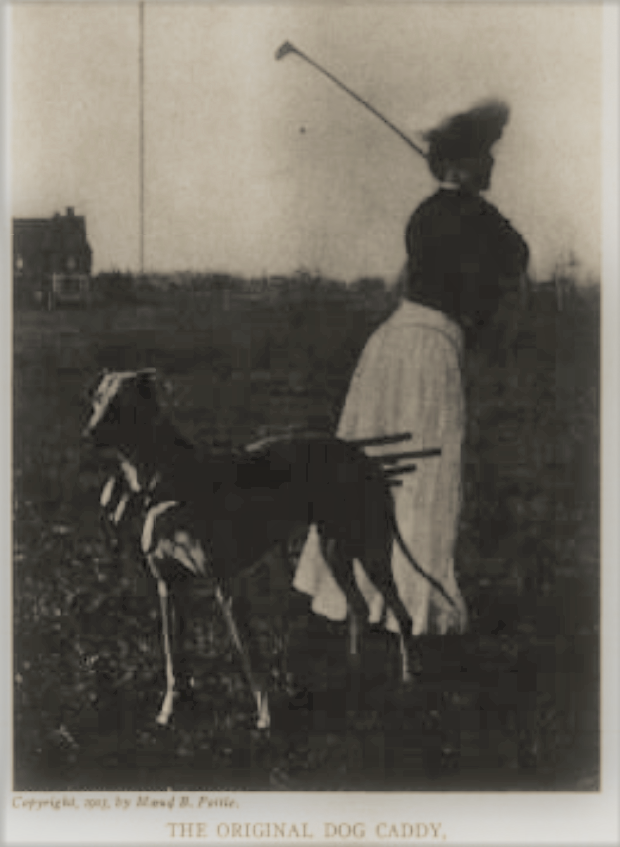
The dog soon became the pride of the members of the Marine and Field Club. In fact, the members thought he was more than equal to Lillian Russell the cat.
Scrap the Dog: Bob’s Rival
During this time, the Marine and Field Club also had another canine mascot. His name was Scrap, aka Pickle (some called him Pickle because he was a mutt of 57 different varieties).
Scrap was owned by H.M. Gotan, a club professional who left the dog at the Marine and Field Club during the winter months when he went to Galveston, Texas. The dog got along with all the golfers, but he did not like any creature on four legs.
One day, Scrap got into a big fight with Bob. It took the strength of several people to hold the greyhound back. A few days later, Scrap was found dead. According to the press, someone had poisoned him.
After 1904, no more articles about Bob the canine gold caddy appeared. One reporter suggested that every golfer would soon have his or her own four-legged caddy, but that prediction does not appear to have come true.
In February 1904, Miss Pottle entered Bob in the Westminster Kennel Club dog show at Madison Square Garden. Bob garnered much attention from the public, but because he did not have pedigree papers, none of the judges paid attention to him.
I don’t know what happened to Bob. I do know that Maud married Frederick Charles Hinkel, a salesman, in 1915. They had one son, Frederick Bruce Henkel.
Maud died on April 27, 1960, and was buried in Poughkeepsie Rural Cemetery. Her husband, who was five years younger, died in 1974.
A Brief History of Bath Beach and the Marine and Field Club
The history of Bath Beach’s development begins with Archibald Young, a young man who made his fortune as a partner in his father’s clothing manufacturing company in Upstate New York. Young has been referred to as the Father of Bath Beach.
In 1852, Young married Mary Ann Wanzer, the daughter of Moses and Mary Wanzer. The Wanzers, who had 10 children, moved from Manhattan to Bath, Long Island, in 1841. They established their home on Gravesend Bay, near the foot of present-day Bay 14th Street (see the map below). This home was later purchased by George Carhart and operated as the Hollywood Hotel in the late 1800s.
During this time, what we now call Bath Beach was a small waterfront settlement known as the village of Bath in the old town of New Utrecht, Long Island.
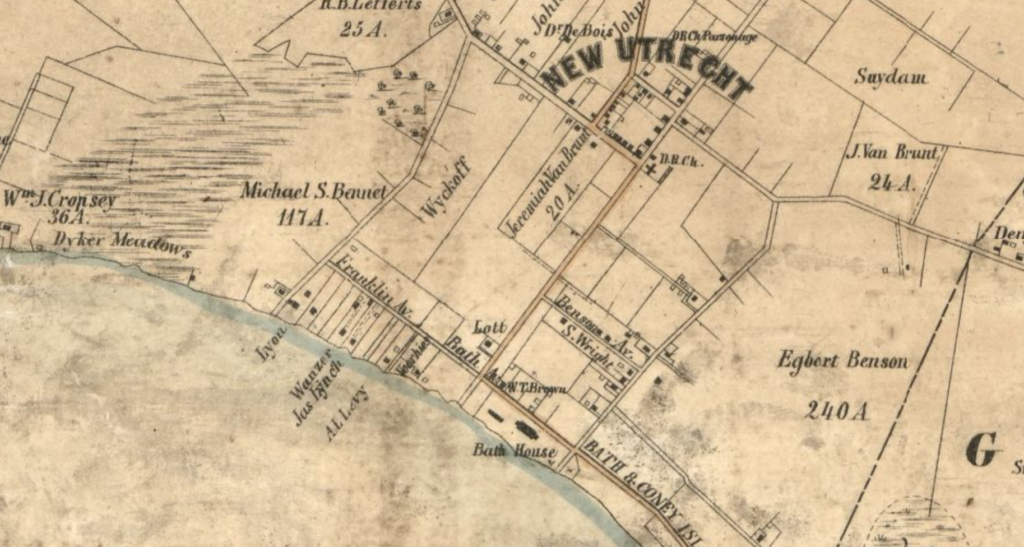
Following his marriage to Mary Ann Wanzer, Young used a portion of his family fortune to purchase the old L-shaped Lott farm, which was just east of the Wanzer property (see map above). He cut the farm into building lots and sold them, thus beginning the development of Bath in earnest.
Young built a magnificent home on Cropsey Avenue between present-day Bay 16th and 17th Streets, which featured a windmill that supplied the house and grounds with water. He and his wife had six children, although only a few daughters survived past childhood.
In 1874, Young and Barney Williams, a well-known Irish comedian and actor, reportedly purchased the old Michael Post farm at Fort Hamilton in a foreclosure sale for $30,000. This parcel included Dyker Meadows, which had been used as a public pasture for 200 years. There was much indignation when Young fenced in the land to keep out the cattle–he even received some death threats until he finally opened the land to cattle again several years later.
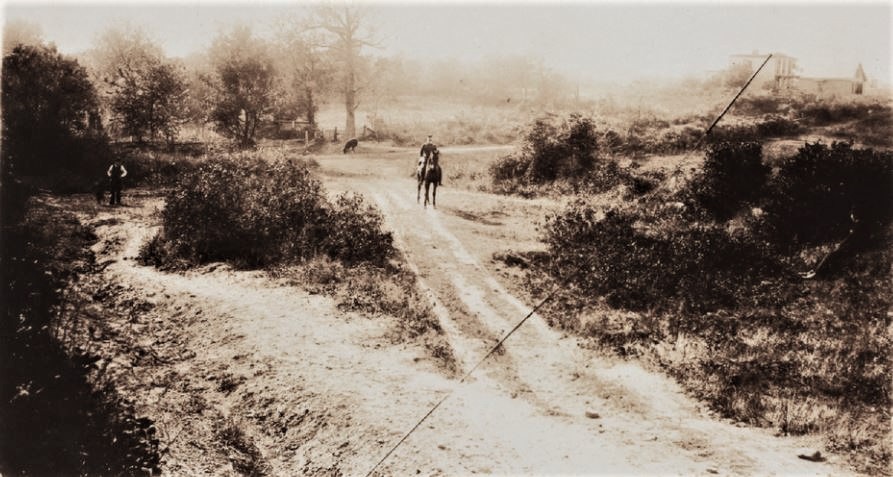
Over the next few years, Young purchased other large parcels of land. He opened a public park on the waterfront and planted numerous maple trees for shade. By 1879, when he became director of the Brooklyn, Bath, and Coney Island Railroad, Young owned about 187 acres in addition to numerous lots.

Around this time, Young and former Magistrate John Lott Nostrand began to cut up their farms into building lots. Combined with improved rapid transit options from Manhattan, the tiny village of Bath became a popular place for both summer and winter residents.
In 1885, the name of the village was changed to Bath Beach to distinguish it from the other village of Bath in Steuben County, New York. That same year, Young purchased 40 acres of the old Cropsey farm. At the time of the sale, the Rural Gazette suggested that Bath “might very well be called Youngstown.”
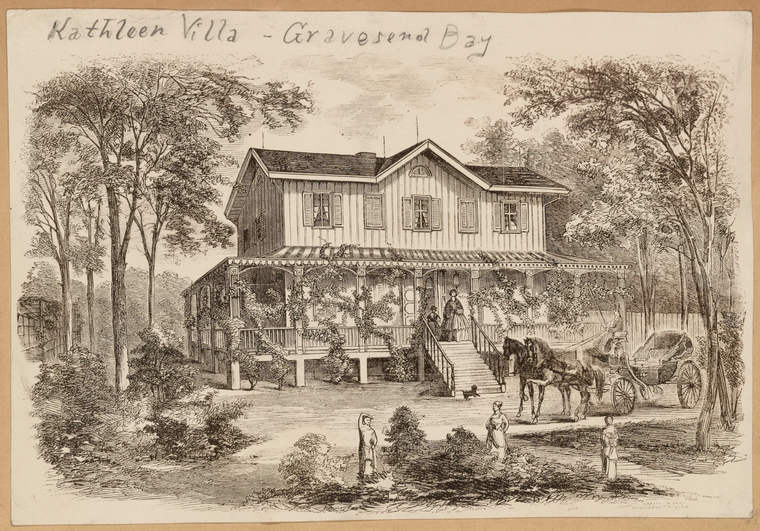
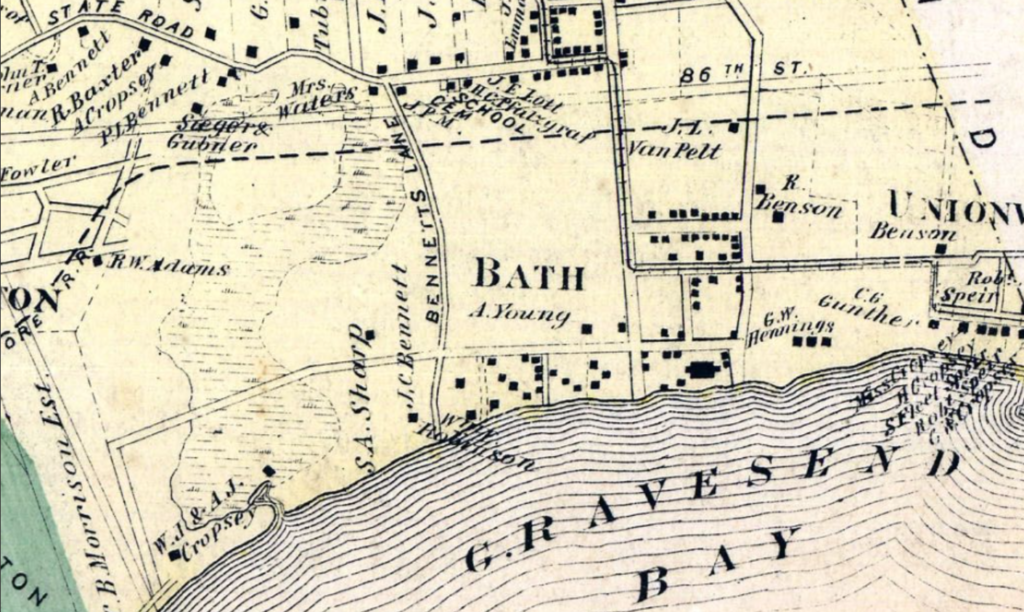
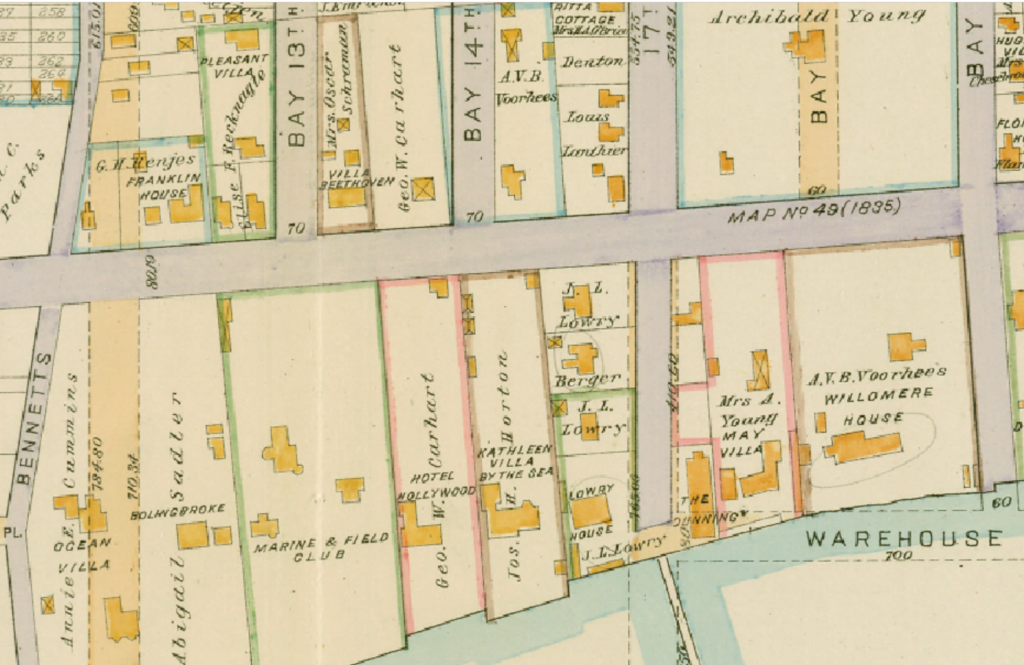
The Columbia Boat Club

The history of the Marine and Field Club goes back to 1872, when there were two rowing clubs in Brooklyn located at the foot of Smith Street on the Gowanus Canal. Two single scullers–Charlie Osborn and Joe Purss–were not members of either club. They joined with another oarsman, Jim Foster, to form their own club called the Columbia Boat Club.
The men bought a small floating boathouse that could hold four boats. They fastened this to a float, from which they rented small rowing and sail boats at the foot of Court Street. After a year, the men had made enough money to build a larger boathouse, which they anchored at the same location.
Over the next few years, the members of the Columbia Boat Club had to float their boathouse to new locations as new docks and other land improvements forced them out. They went from the foot of 49th Street in 1877, to the grounds of the Avon Beach Hotel at Bay 22nd Street in 1884, to the foot of 55th Street in Bay Ridge a year later.

Finally, after building a larger boathouse (pictured below), they moved to Bay 13th Street, where the structure stood on spikes over the water.
In 1886, about a dozen members of the boat club joined together to buy several acres of property from Carl L. Recknagel, an importer of pharmaceuticals who owned a home and several rentable cottages on Bay 13th Street. The total cost for the grounds, main house, and cottage was $35,000. Recknagel had built the main home in 1881; at that time, it was considered one of the most elegant in the village of Bath.
The first annual meeting of the new social club was held on January 12 1886, at the Hotel St. George. The men were originally going to call the new club the Brooklyn Land and Water Club, but apparently they changed it to the Marine and Field Club.
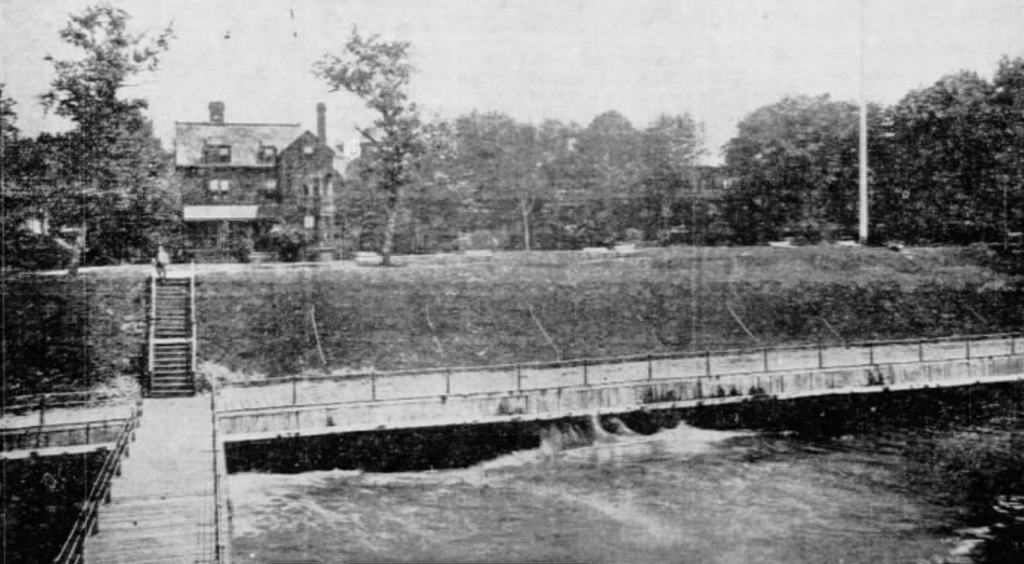
The men’s intention was to form a country club within easy access of New York and Brooklyn. The club would have 10 lawn tennis courts, plus boating, swimming, fishing, sailing, canoeing, and rowing. Charles Stokes was elected president and Hugh Boyd vice president.
In 1888, the Marine and Field Club built a large dormitory for men called Tower Hall. This building, which was off-limits to women, featured a carpeted lounge with a piano, a billiard hall with four tables, a bar, and a wine room. Bedrooms plus a shower and bath were on the upper two floors.

Tower Hall was popular with the bachelor members, although there were radio communications for married men to communicate with their wives staying in the cottage sleeping apartments.
In 1896, under the direction of Percy S. Mallett, a nine-hole course was laid out on about 50 acres south of 86th Street adjoining the nine-hole Dyker Meadow course. The course was about two miles from the clubhouse at Bay 13th Street.
According to the New York Journal, “The members of the club, and the women in particular, have taken such an interest in the game that the Green Committee had a temporary seven-hole course laid out” while the full course was being constructed. The temporary course was short, which was perfect for beginning golfers.
About ten years later, in 1909, the two social clubs made an agreement to give members of both clubs access to a combined 18-hole course. The agreement came to an end in April 1914, when the opening of 12th Avenue damaged part of the course that the Marine and Field Club was leasing from the estate of George J. Smith.
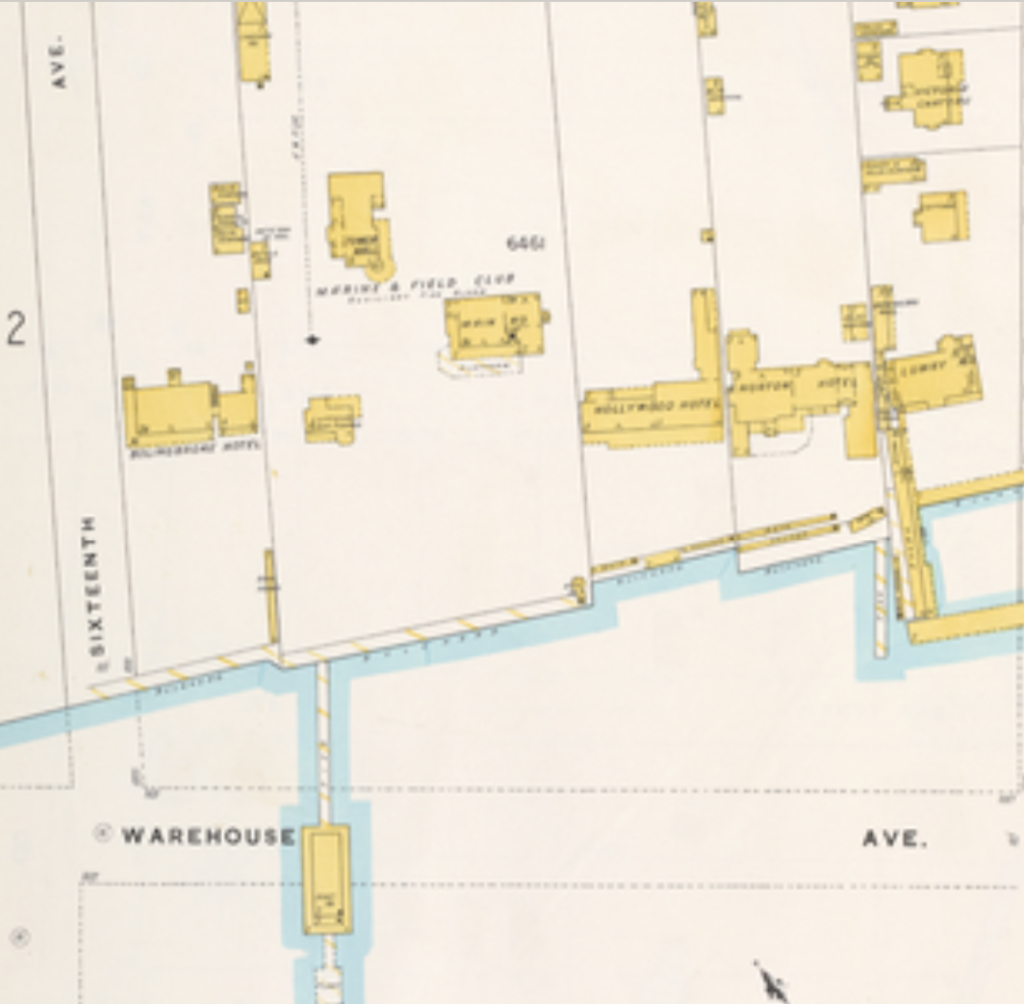
In 1926, the Smith estate sold the land to a corporation headed by Isaac Perchelsky, a real estate operator and builder. The corporation applied for a building permit, but it was turned down because the Parks Department was already making plans to purchase the land to create what is now the Dyker Beach Park and Golf Course.
In 1935, a bad storm wrecked the pier and tore the roof off the Marine and Field Club boathouse. When the Belt Parkway was constructed a few years later, it left the club high and dry and at least a quarter of a mile from the water. The club moved to 3000 Emmons Avenue in Sheepshead Bay, where it continued to operate as a social club through the 1940s.
By 1941, builders had taken over the former Marine and Field Club property. The site was soon replaced by a settlement of one-family brick homes that are still standing today.
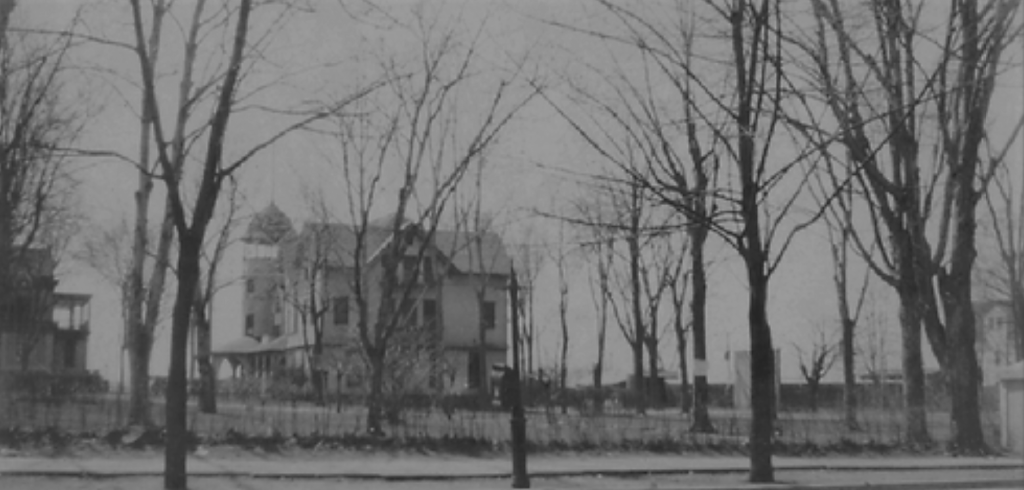

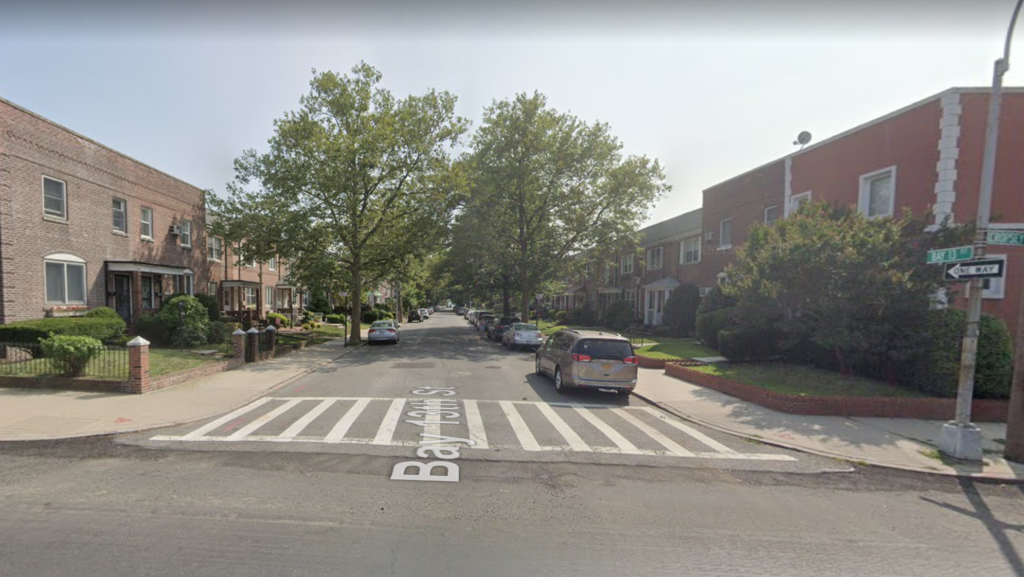



I recently acquired a lovely chafing dish made by Gorham that was a trophy – Engraved “Marine & Field Club Lawn Tennis Championship 1892”. I was pleased to learn more about the club’s history! Thank you!